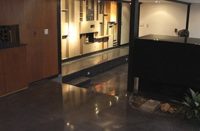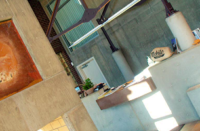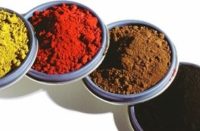
Frank and Jackie Davis fled their native Austria after the Nazis confiscated their pigment business during World War II. After settling in southern California, Frank used his training as a chemist and colorist to blend and distribute pigments especially for the concrete industry. His love of color, heightened by the freedom he experienced after escaping the war, was expressed in his philosophy: “Color is light. Light is life. Color is life.”
His company, incorporated in 1952 as the Frank D. Davis Company, remains a pioneer in the use of iron oxide pigments for coloring concrete. Now known as Davis Colors, the company has grown to become a global leader, with more than 140 employees, manufacturing facilities on three continents and the largest line of pigments and automated color-dosing systems in the construction industry.

Since the company began, integrally colored concrete has become part of the fabric of our landscape. Colored concrete is now used in every part of the country and is acknowledged as an important design option for all forms of concrete construction. In the ready mixed concrete industry, it is found in everything from the most humble driveway to the grandest of monuments. Precast concrete owes part of its growing popularity to the design versatility of colored concrete finishes. And colored products now dominate the market for concrete masonry units.
Initially, colored concrete was used primarily in small projects such as sidewalks. To prove the reliability of color additives, Frank Davis collaborated with industry associations to establish standards. As confidence in the material increased, colored concrete became stylish on larger projects. Frank Lloyd Wright, a pioneer in the development of architectural concrete, worked with Davis Colors on the Grady Gamage Auditorium, built in 1959 at Arizona State University. Integrally colored concrete was also used in the mid-1960s reconstruction of San Francisco’s famous Palace of Fine Arts.
Over the years, colored concrete has kept pace with changing tastes and building methods. In the 1970s, for example, Davis Colors provided the adobe tones for the CMU slump blocks that were enjoying popularity. Today, on the other hand, color is a big part of the appeal of interlocking concrete paving units, a concrete masonry product which is rapidly gaining market share. Color has also found a home in pattern-stamped concrete simulating brick, stone and other textured pavements.
Throughout the 1990s, colored concrete was increasingly used in environmentally sensitive projects — such as a bridge in Zion National Park and the parking structure at the Hoover Dam Visitor Center — where earth-toned pigments harmonized with the natural landscape. Other environmental benefits of integrally colored concrete have also gained in importance. In comparison to painting a concrete structure, for instance, integral colors are free of volatile organic compounds and provide a permanent finish that improves life-cycle value by eliminating the need to reapply coatings.
And of course, colored concrete is now immensely popular as an interior finish and is now used for flooring and countertops in both homes and commercial establishments.

Frank Davis’ company was renamed Davis Colors in 1976 when it became a division of Rockwood Industries. It continues today as a division of Rockwood Pigments, the global pigment division of Rockwood Specialties Inc. In addition to its original manufacturing facility in Los Angeles, Calif., Davis Colors now has facilities in Maryland, Missouri, Germany, Italy, and the United Kingdom, as well as a joint venture in China. The company is vertically integrated, synthesizing its own iron oxide pigments as well as blending, liquefying and granulating colors to meet a variety of customer requirements.
The Davis Colors product line includes concentrated pigment powders, Hydrotint liquid slurries, Granufin low-dust granulated pigments, and packaged pigments such as True Tone mortar colors and Mix-Ready disintegrating bags for convenient dosing of mobile concrete mixers. The company also produces automatic, computer-controlled concrete coloring systems, including Granumat for use with granulated pigments and Chameleon for use with liquid slurries.
“As people continue to understand the beauty of colored concrete and the value it provides concrete producers and homeowners, they will find more ways to use color,” says Rockwood pigments managing director Ronald L. Rapaport. “We are excited by and ready for the challenges of the next fifty years.”
To learn more about Davis Colors visit the Davis Colors Web site.












